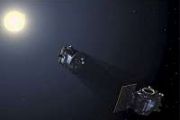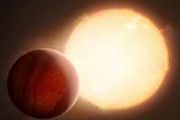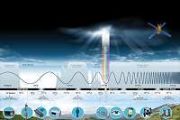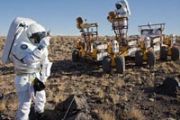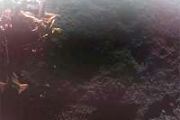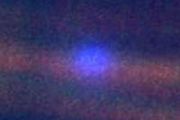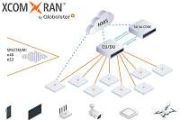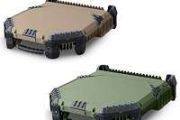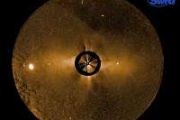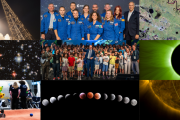
Copernical Team
CesiumAstro to supply 7 comms payloads to Raytheon for SDA Tranche 1 Tracking Layer.
Draft RFP released for Space Test Experiments Platform STEP 2
 A Draft Request for Proposal (DRFP) for the Space Test Experiments Platform (STEP) 2.0 contract effort is available now via SAM.gov for industry feedback submissions through Friday, May 19.
This groundbreaking STEP 2.0 initiative is an integral next step in the U.S. Department of Defense (DoD) Space Test Program (STP) managed by Space Systems Command (SSC). STEP 2.0 aims to advance the Uni
A Draft Request for Proposal (DRFP) for the Space Test Experiments Platform (STEP) 2.0 contract effort is available now via SAM.gov for industry feedback submissions through Friday, May 19.
This groundbreaking STEP 2.0 initiative is an integral next step in the U.S. Department of Defense (DoD) Space Test Program (STP) managed by Space Systems Command (SSC). STEP 2.0 aims to advance the Uni SSC Evolved Strategic SATCOM Program uses competition to drive threat-focused
 In response to growing space threats, the Space System Command's (SSC) Space Development Corps Evolved Strategic Satellite Communications (SATCOM) program, ESS, is aggressively leveraging Middle Tier Acquisition authorities and competition to rapidly identify, prototype, and field an innovative next-generation strategic SATCOM system.
From Sept. - Nov. 2020, the Space Systems Command award
In response to growing space threats, the Space System Command's (SSC) Space Development Corps Evolved Strategic Satellite Communications (SATCOM) program, ESS, is aggressively leveraging Middle Tier Acquisition authorities and competition to rapidly identify, prototype, and field an innovative next-generation strategic SATCOM system.
From Sept. - Nov. 2020, the Space Systems Command award Airbus Eurostar Neo Arabsat BADR-8 telecoms satellite shipped to launch site
 Airbus' latest next generation geostationary Eurostar Neo satellite Arabsat BADR-8 has been shipped to Cape Canaveral, ready for launch. The satellite will provide connectivity over Europe, Middle East, Africa, and central Asia and also features a world first Airbus' innovative space demonstrator TELEO to provide space to ground optical communicationsc at gigabit speeds.
Airbus' relationsh
Airbus' latest next generation geostationary Eurostar Neo satellite Arabsat BADR-8 has been shipped to Cape Canaveral, ready for launch. The satellite will provide connectivity over Europe, Middle East, Africa, and central Asia and also features a world first Airbus' innovative space demonstrator TELEO to provide space to ground optical communicationsc at gigabit speeds.
Airbus' relationsh Japan okays GPS tracking for bail after Ghosn case
 Japan on Wednesday enacted a law authorising courts to use GPS for tracking defendants on bail, a measure pushed for after the dramatic 2019 escape of former Nissan boss Carlos Ghosn.
The revised criminal proceedings law approved Wednesday will enable courts to order the placement of GPS devices on defendants to prevent them from fleeing Japan.
The defendants will be banned from removin
Japan on Wednesday enacted a law authorising courts to use GPS for tracking defendants on bail, a measure pushed for after the dramatic 2019 escape of former Nissan boss Carlos Ghosn.
The revised criminal proceedings law approved Wednesday will enable courts to order the placement of GPS devices on defendants to prevent them from fleeing Japan.
The defendants will be banned from removin EELS slithers into new robotics terrain
 A versatile robot that would autonomously map, traverse, and explore previously inaccessible destinations is being put to the test at NASA's Jet Propulsion Laboratory.
How do you create a robot that can go places no one has ever seen before - on its own, without real-time human input? A team at NASA's Jet Propulsion Laboratory that's creating a snake-like robot for traversing extreme terra
A versatile robot that would autonomously map, traverse, and explore previously inaccessible destinations is being put to the test at NASA's Jet Propulsion Laboratory.
How do you create a robot that can go places no one has ever seen before - on its own, without real-time human input? A team at NASA's Jet Propulsion Laboratory that's creating a snake-like robot for traversing extreme terra How NASA's work led to commercial spaceflight revolution
 For more than 60 years, NASA has pushed the boundaries of human exploration for the benefit of all, and now the agency's influence and experience are fueling U.S. commercial industry's growth in human spaceflight in low Earth orbit.
In the not-too-distant past, one had to be sponsored by a government to fly to space. Now, fully private crews strap into commercially owned and operated human
For more than 60 years, NASA has pushed the boundaries of human exploration for the benefit of all, and now the agency's influence and experience are fueling U.S. commercial industry's growth in human spaceflight in low Earth orbit.
In the not-too-distant past, one had to be sponsored by a government to fly to space. Now, fully private crews strap into commercially owned and operated human UK gives Viasat clearance to acquire Inmarsat
 Viasat Inc., (NASDAQ: VSAT), a global communications company, and Inmarsat, a leading provider of global mobile satellite communications services, are pleased that the UK's Competition and Markets Authority (CMA) has announced the conclusion of its Phase II review, which confirmed its provisional findings that the transaction does not raise competition concerns, and allows Viasat's proposed acqu
Viasat Inc., (NASDAQ: VSAT), a global communications company, and Inmarsat, a leading provider of global mobile satellite communications services, are pleased that the UK's Competition and Markets Authority (CMA) has announced the conclusion of its Phase II review, which confirmed its provisional findings that the transaction does not raise competition concerns, and allows Viasat's proposed acqu SwRI selected for Phase A study to develop next-generation NOAA coronagraph
 NASA has selected Southwest Research Institute for a Phase A study to develop SwRI's Space Weather Solar Coronagraph (SwSCOR) on behalf of the National Oceanic and Atmospheric Administration (NOAA). NOAA's Space Weather Next Program is charged with providing critical data for its space weather prediction center. SwRI is one of five organizations developing a definition-phase study to produce the
NASA has selected Southwest Research Institute for a Phase A study to develop SwRI's Space Weather Solar Coronagraph (SwSCOR) on behalf of the National Oceanic and Atmospheric Administration (NOAA). NOAA's Space Weather Next Program is charged with providing critical data for its space weather prediction center. SwRI is one of five organizations developing a definition-phase study to produce the Ubajara drill site gets green light: Sols 3823-3824
 Earth planning date: Monday, May 8, 2023.
A lot of preparation goes into assessing a potential drill site on Mars, and the "Ubajara" target got the usual treatment. Over the past several sols, Curiosity has diligently characterized the potential "Ubajara" drill site with activities such as MAHLI and APXS, brushing it with the dust removal tool, and completing a "preload" test.
The preload
Earth planning date: Monday, May 8, 2023.
A lot of preparation goes into assessing a potential drill site on Mars, and the "Ubajara" target got the usual treatment. Over the past several sols, Curiosity has diligently characterized the potential "Ubajara" drill site with activities such as MAHLI and APXS, brushing it with the dust removal tool, and completing a "preload" test.
The preload 












